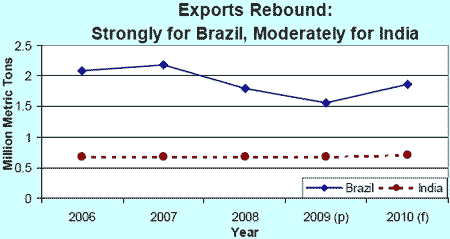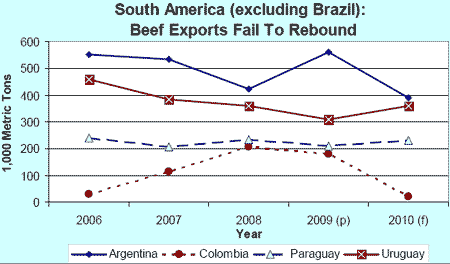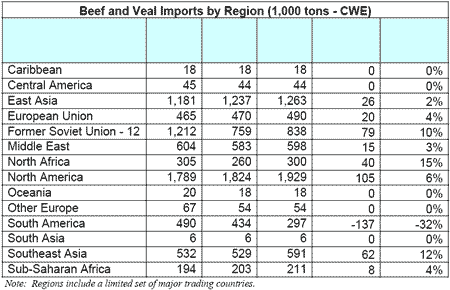



World Beef Trade Overview - October 2009
By USDA Foreign Agricultural Service - This article provides a forecast for 2010, in which an economic recovery is expected to bolster world meat trade.2010 Forecast: Economic Recovery Bolsters World Meat Trade
Economic recovery in 2010 will help stimulate improved demand for meat and poultry.

Beef and pork exports are forecast up one and three per cent, respectively. Whereas improved demand for beef is expected worldwide, the boost in pork will generally be concentrated in North America. Brazil, the only key beef producer with excess supplies, is expected as the principal beneficiary of increased demand. However, both Brazil and the United States will be able to take advantage of the rise in pork.
Broiler and turkey meat exports are forecast two and four per cent higher, respectively. Brazil will be the primary supplier as it focuses on growth to non-traditional markets. The United States faces a decline in broiler shipments on weak demand in major markets but modest growth is expected for turkey.
Beef: 2010 Forecast Overview
World beef and veal production down slightly to 56.4 million tons
Beef production in 2010 is forecast to continue its recent decline, albeit at a slower rate of less than one per cent. Production increases in Brazil (four per cent) and India (five per cent) will not offset lower production in Argentina (13 per cent), China (four per cent) and the United States (two per cent).

Argentina: Production is forecast to tumble 13 per cent to 2.8 million tons on tighter cattle inventories. Argentina is expected to begin 2010 with a herd of 50.2 million head, 10 per cent lower than just two years ago. Drought, persisting in most of the country since mid-2007, has been the primary driver of herd reduction generating lower calf crops on diminished pregnancy rates and depressed returns have forced producers to market more cattle than usual. Thus liquidation in 2008 and 2009 will come to fruition in 2010 as fewer weaned calves, a smaller herd and a reduction of cows for slaughter will limit supplies. Export restrictions, domestic policies capping beef prices, and reduced profit margins will also stifle investment and production.
China: Continuing contraction of the cattle herd is forecast to negatively impact beef production, which will fall to just over 5.5 million tons – comparable to the levels of 2003/2004. The herd, estimated at 104.9 million head at the beginning of 2010, will have contracted for two years. Backyard producers, which account for the majority of holdings, have been discouraged by a marketing system disadvantageous to small producers. Despite high cattle prices, production costs have risen at a faster rate, squeezing profit margins. Uncertainty in the sector, which stifles production, has also been fostered by continued outbreaks of foot and mouth disease (FMD).
United States: Production is forecast to decline nearly two per cent to 11.6 million tons on tighter supplies as the cattle herd has been contracting since 2007.
Brazil: Production is forecast to rise four per cent to 9.3 million tons. Unlike other major producers, the herd continues to expand and is forecast to reach 185.2 million head by 2010. Increased availability of slaughter cattle will not only enable packers to meet strong demand for exports, which accounts for the bulk of the increase, but also satisfy solid domestic demand.
India: With the world's largest bovine herd, beef and buffalo meat production is forecast to rise five per cent, primarily driven by strong domestic demand. Buffalo meat is cost competitive compared to other meat products and is widely accepted among Indian consumers. Firm demand for exports will also bolster production.
Exports: Recovery in 2010 elusive
World trade is forecast to rise a mere one per cent as global demand fails to fully rebound and major suppliers struggle to generate adequate supplies. Australian and New Zealand exports are forecast to fall three and two per cent, respectively, as they will be limited by production declines. Brazil is forecast to rise a stunning 20 per cent – a trend that will not apply to its South American counterparts.

Brazil: Although the cattle sector is facing challenges due to industry restructuring and two years of reduced exports, the outlook for 2010 is extremely positive with exports rising to nearly 1.9 million tons. While still below the historical high of 2007, the increase will reinforce Brazil's position as the world’s largest beef exporter and restore global market share. It is expected that global economic recovery could generate opportunities in the Middle East, recovery of shipments to the EU will continue, limited competing South American supplies will spur shipments to Russia, and the Columbia-Venezuela dispute will open avenues into Venezuela.
India: Exports are forecast to rise four per cent to a historic 700,000 tons. Global demand for Indian buffalo meat is gradually growing due to its cost competitiveness, leanness, and perceived organic nature. However sales will remain limited to non-traditional, albeit growth, markets.
United States: Exports are forecast to rise seven per cent to 837,000 tons, a level still below that of 2008 and pre-BSE. Economic recovery in Canada and Mexico, the principal markets, are expected to drive the growth as well as greater Chinese demand.
Argentina: Plummeting production is forecast to reduce exportable supplies in 2010. The principal products and destinations will be high-value chilled cuts to the EU (Hilton Quota), thermo-processed products to the EU, chilled cuts to Chile and frozen cuts to Russia, Venezuela and Israel. Exports of thermo-processed product to the United States are expected to remain stable or slightly diminish.
Columbia: Exports are forecast to decline nearly 90 per cent from 180,000 tons in 2009 to a mere 20,000 tons in 2010. Trade is dependent on the Venezuelan market and the current trade disruption will result in increased production remaining in-country for domestic consumption.


Imports: Lacklustre as demand is slow to rebound from recession
Global economic recovery will somewhat renew demand in 2010 and there will be few countries with noteworthy forecasts.
Russia: In the absence of a multilateral agreement on 2010 TRQs, the forecast is based on 2009 TRQ levels and allocations. As production declines persist and the economy rebounds, imports are expected to continue to fulfill demand. Imports are forecast to rise 11 per cent to 780,000 remaining well below the 2008 peak.
United States: The world's largest beef importer is forecast to increase by four per cent to 1.3 million tons bolstered by reduced US production, a strong dollar, and robust demand for lean trimmings.
EU: Imports are forecast upward by four per cent to 490,000 tons. Although lower production is expected to boost imports, it will be moderately constrained by stagnant demand as other proteins, particularly poultry, continue to make consumption gains.
Venezuela: Imports will plunge 60 per cent to 100,000 tons despite growing demand as imports will be limited by its disruption with Columbia. With other South American producers failing to raise substantial supplies, Brazil is likely to be the key supplier.

Further Reading
| - | You can view the full report by clicking here. |
October 2009


